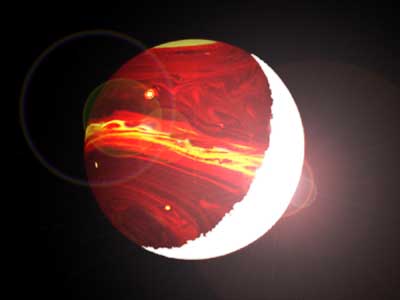Michal Levinstein, Israel Astronomical Society

Direct link to this page: https://www.hayadan.org.il/op080705.html
NASA researchers have discovered the largest solid core so far in a planet outside the solar system (extrasolar). The discovery provides evidence for the "Core Accretion" theory of planet formation, according to which planets are initially formed as balls of rock and ice, and gradually collect a shell of gas around them.
For theorists, this discovery is just as important as the discovery of the first planet outside the solar system in 1995 - 51 Pegasi - says Shigeru Ida (a theorist from the Tokyo Institute of Technology in Japan).
When a consortium of American, Japanese and Chilean scientists first observed the planet, they expected to see a Jupiter-like Ide. "None of the models observed a planet with similar characteristics to the one we discovered" says Bun'ei Sato (team member and postdoctoral fellow at the Okayama Observatory in Japan).
Scientists rarely have such an opportunity - to collect solid evidence regarding the formation of planets. More than 150 exoplanets have been discovered so far, through observations of the speed of their suns as they move toward and from Earth. The changes in the speed of the suns are caused by the gravitational forces of their planets.
Also, when a planet passes in front of its sun - it causes a decrease in its brightness. "When this happens, we can calculate the physical size of the planet, whether it has a solid core and even what kind of atmosphere it has" says Debra Fischer (leader of the consortium and professor of astronomy at the University of San Francisco California in the USA).
The discovered planet - orbiting the sun HD 149026 - has a mass similar to that of Saturn, but is significantly smaller in diameter. It orbits its sun in only 2.87 days. The temperature of its upper atmosphere is 2,000 degrees Fahrenheit. When building a model of the planet's structure, they find that it has a solid core with a mass 70 times that of the Earth.
This is the first observational evidence for the "Core Accretion" theory of planet formation. Scientists have two competing but viable theories for the formation of planets: The Gravitational Instability theory claims that planets form from the rapid collapse of a compressed cloud. In contrast, the core accretion theory claims that planets begin their journey as small balls of rock and ice and grow as their gravity requires additional mass. The scientists do not believe that the rocky core was formed by the collapse of a cloud, but was formed first and then absorbed gas into it.
"This is confirmation of the "Core Accretion" theory for the formation of planets and evidence that many planets of this type may exist" says Greg Henry (astronomer from the University of Tennessee Nashville in the USA). He detected the dimming of sunlight as the planet passed in front of it using a robotic telescope at the Fairburn Observatory in Mount Hopkins, Arizona, USA.
For information on the Universe Today website
The Israeli Astronomical Society
Know planets outside the solar system
https://www.hayadan.org.il/BuildaGate4/general2/data_card.php?Cat=~~~199911952~~~54&SiteName=hayadan
